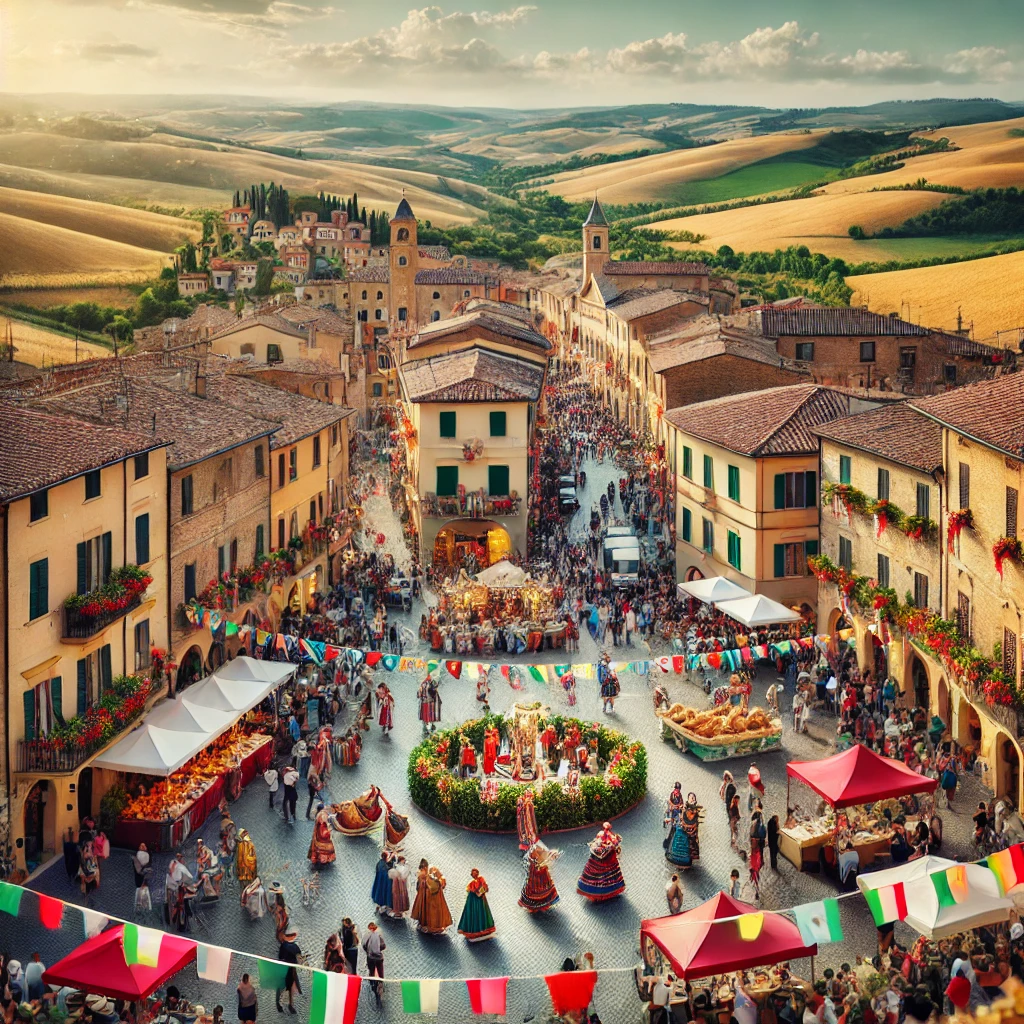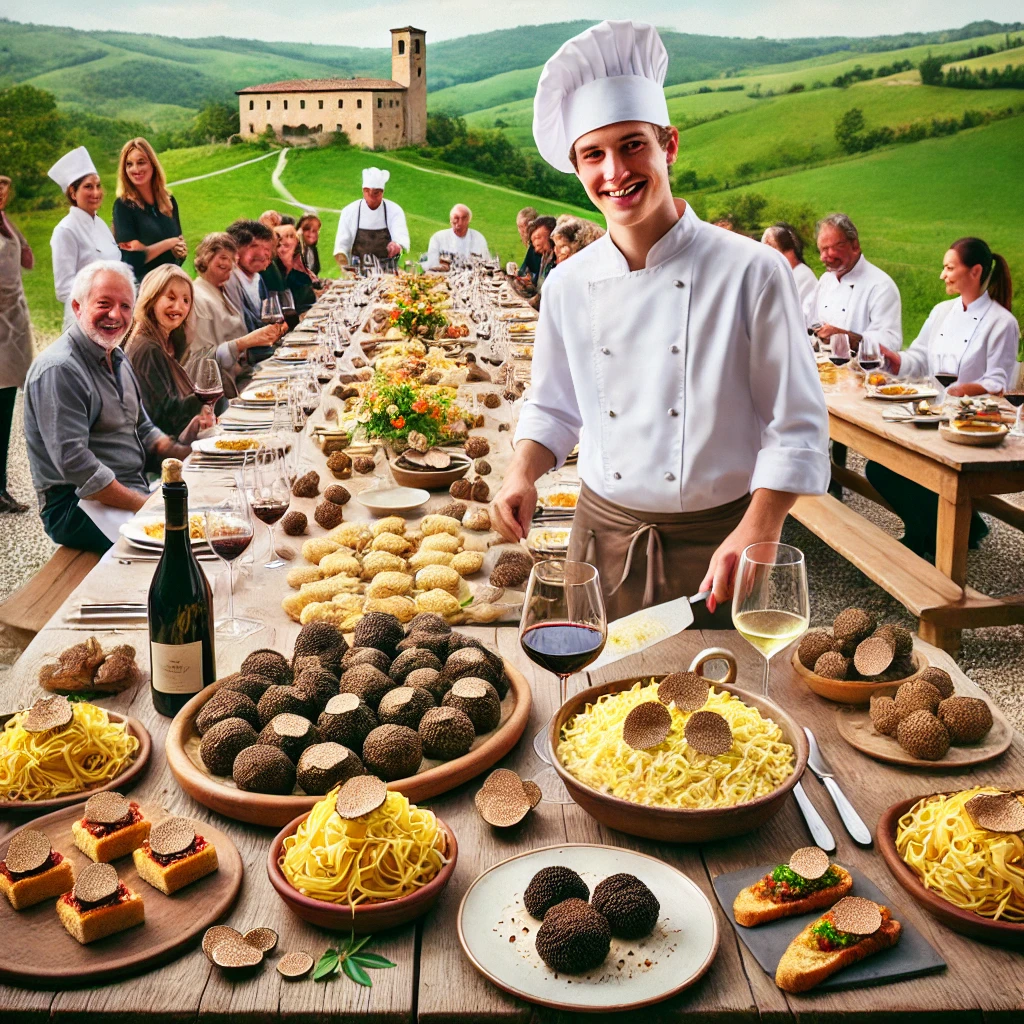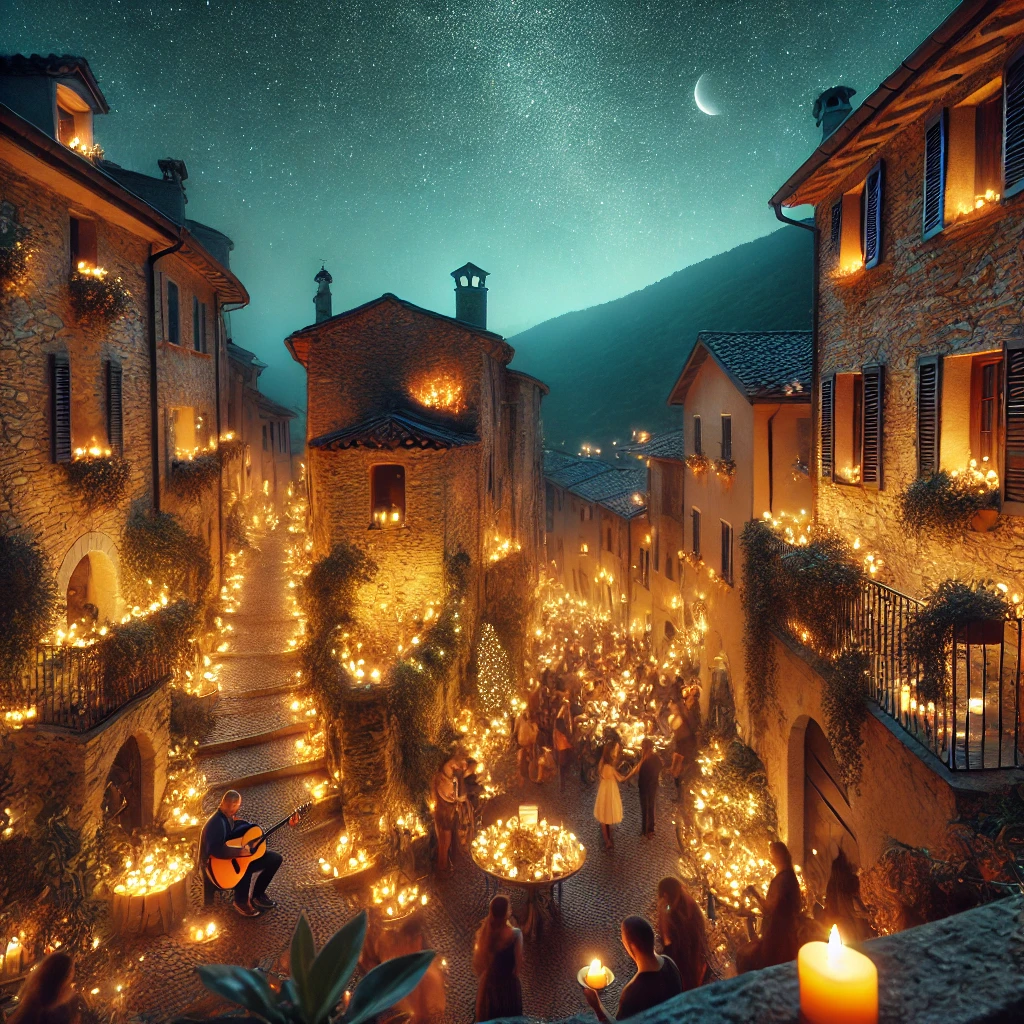
Italy, with its rich history, cultural traditions, and breathtaking landscapes, is one of the most fascinating destinations in the world, especially during the summer. This is the time when the country comes alive with festivals and fairs that celebrate everything from local cuisine to music, from art to religion. Every region, city, and even small village offers a variety of events that attract both locals and tourists.
This comprehensive guide to summer festivals and fairs in Italy will help you discover the most significant events, providing useful details on what to expect, where to go, and how to participate in these unique experiences.
Table of Contents
- Introduction to Summer Festivals and Fairs in Italy
- The Tradition of Fairs in Italy
- 2.1 Origins of Fairs2.2 The Importance of Fairs in Local Communities
- Religious Festivals and Processions
- 3.1 The Feast of St. John the Baptist (Florence, Genoa, and Turin)3.2 The Feast of Our Lady of the Snow (Campania and Apulia)
- Gastronomic Fairs: A Journey Through Regional Flavors
- 4.1 The Truffle Fair (Umbria)4.2 The Fish Fair (Liguria)4.3 The Porchetta Fair (Ariccia, Lazio)
- Historical Festivals and Reenactments
- 5.1 The Palio of Siena (Tuscany)5.2 The Joust of the Saracen (Arezzo, Tuscany)
- Music Festivals and Open-Air Concerts
- 6.1 Umbria Jazz (Perugia)6.2 La Notte della Taranta (Apulia)
- Arts and Crafts Fairs
- 7.1 The Neighborhood Festival (Marche)7.2 Craft Fair (Florence)
- Wine Festivals and Harvest Celebrations
- 8.1 The Wine Festival (Chianti, Tuscany)8.2 Calici di Stelle (Various Locations)
- Folkloric Events and Popular Traditions
- 9.1 The Night of Candles (Viterbo)9.2 The Parade of Giants (Nola, Campania)
- How to Plan Your Visit
- 10.1 Practical Tips10.2 Best Times to Travel
- Conclusion
- FAQ
1. Introduction to Summer Festivals and Fairs in Italy
Summer in Italy is not just about the sea and the sun; it’s also a season rich in cultural events that allow visitors to immerse themselves in local life. The summer festivals and fairs represent the heartbeat of Italian traditions, celebrating the country’s cultural heritage through food, music, religion, and history.
Attending one of these events means not just witnessing a celebration, but also experiencing an authentic slice of life that reflects the soul of local communities. From religious celebrations of patron saints to gastronomic fairs, every festival has its unique flavor, showcasing the cultural diversity of the various Italian regions.
2. The Tradition of Fairs in Italy
2.1 Origins of Fairs
Italian fairs have their roots in ancient pagan celebrations and agricultural traditions. Originally, they were festive moments linked to agricultural cycles, such as the grape harvest, olive picking, or wheat harvest. Over time, many of these celebrations merged with religious festivals, creating events that combine devotion, food, and entertainment.
2.2 The Importance of Fairs in Local Communities
Fairs are not just festive occasions; they are also opportunities for local communities to strengthen social bonds and preserve traditions. Every fair is a chance to showcase local products, promote tourism, and, above all, keep alive customs and practices passed down through generations.
3. Religious Festivals and Processions
Italy is a deeply religious country, and many of the most important summer festivals are tied to religious celebrations. These festivals, often accompanied by spectacular processions, attract thousands of faithful and tourists.
3.1 The Feast of St. John the Baptist (Florence, Genoa, and Turin)
The Feast of St. John the Baptist, celebrated on June 24, is one of the oldest and most important religious festivals in Italy. St. John is the patron saint of many Italian cities, including Florence, Genoa, and Turin. In these cities, the festival is marked by processions, fireworks, and various cultural events. In Florence, for example, the celebration includes the traditional ‘Scoppio del Carro,’ a pyrotechnic display symbolizing good luck and prosperity.
3.2 The Feast of Our Lady of the Snow (Campania and Apulia)
Celebrated on August 5, the Feast of Our Lady of the Snow is one of the most beloved Marian festivals, especially in southern regions like Campania and Apulia. The festival commemorates the miracle of a summer snowfall that occurred in Rome in 352 AD. During the celebrations, statues of the Virgin Mary are carried in processions through the streets, accompanied by songs, prayers, and fireworks.

4. Gastronomic Fairs: A Journey Through Regional Flavors
Italy is famous worldwide for its cuisine, and gastronomic fairs are the perfect opportunity to taste the traditional dishes of various regions.
4.1 The Truffle Fair (Umbria)
Umbria, with its lush forests, is the ideal place for truffle hunting, one of the most prized ingredients in Italian cuisine. The Truffle Fair is held in various Umbrian towns, including Norcia and Acqualagna, and is a must-visit for anyone looking to savor traditional dishes featuring truffles, such as tagliatelle, frittatas, and bruschettas.
4.2 The Fish Fair (Liguria)
In Camogli, Liguria, the famous Fish Fair is held every second Sunday of May. This event is renowned for the gigantic frying pan used to fry fish, which is then distributed for free to the participants. The fair is also a festive occasion with music, dancing, and fireworks over the sea.
4.3 The Porchetta Fair (Ariccia, Lazio)
Ariccia, a small town near Rome, is famous for its porchetta, a dish of roast pork seasoned with aromatic herbs. The Porchetta Fair, held in September, attracts thousands of visitors who come to enjoy this delicious dish accompanied by crispy bread and local wine.
5. Historical Festivals and Reenactments
Historical festivals and reenactments in Italy offer a fascinating glimpse into the country’s past, bringing to life events, battles, and historical figures.
5.1 The Palio of Siena (Tuscany)
The Palio of Siena is perhaps the most famous historical reenactment in Italy. This horse race, held twice a year (July 2 and August 16) in the stunning Piazza del Campo, dates back to the Middle Ages and involves the 17 districts of Siena. The Palio is not just a race, but an event that engages the entire city with dinners, historical parades, and celebrations that last for weeks.
5.2 The Joust of the Saracen (Arezzo, Tuscany)
The Joust of the Saracen is a medieval reenactment held in Arezzo twice a year, in June and September. This chivalric tournament, which originated in the 13th century, sees the knights of the four districts of Arezzo compete in an exciting contest in which they must hit a target placed on the shield of a mannequin representing a Saracen.
6. Music Festivals and Open-Air Concerts
Italian summers are also synonymous with music and open-air concerts, ranging from jazz to folk music.
6.1 Umbria Jazz (Perugia)
Umbria Jazz is one of the most important jazz music festivals on an international level. Every year in July, Perugia transforms into an open-air stage for world-renowned jazz artists. The festival offers both free and paid concerts in various locations around the city, from squares to theaters, making it a must-attend event for music lovers.
6.2 La Notte della Taranta (Apulia)
La Notte della Taranta is one of the largest folk music festivals in Italy, dedicated to the pizzica, the traditional dance of Salento. The festival culminates in a grand concert held every year in August in Melpignano, in the province of Lecce. The event is a celebration of Salentine culture, with dances, music, and performances that attract thousands of spectators.
7. Arts and Crafts Fairs
Fairs dedicated to arts and crafts offer a glimpse into Italy’s artisan traditions, celebrating local talent and creativity.
7.1 The Neighborhood Festival (Marche)
The Neighborhood Festival, held in various towns in the Marche region, is a celebration of local arts and crafts. During the event, the streets of the villages come alive with artisan workshops, exhibitions, and demonstrations where visitors can watch master ceramists, carpenters, tailors, and other artisans at work.
7.2 Craft Fair (Florence)
The Florence International Handicrafts Fair is one of the most important events in the Italian handicraft scene. It takes place every year at the end of April in the Fortezza da Basso and hosts exhibitors from all over Italy and abroad, offering a wide range of handcrafted products, from jewelry to textiles, from ceramics to woodwork.

8. Wine Festivals and Harvest Celebrations
Italy, with its countless wine varieties, celebrates the grape harvest with festivals that are a tribute to taste and winemaking tradition.
8.1 The Wine Festival (Chianti, Tuscany)
The Chianti region, famous for its fine wines, hosts numerous wine festivals during the summer. One of the best-known is the Wine Festival in Greve in Chianti, held in September. During the event, visitors can taste wines from the best local wineries, accompanied by typical Tuscan products.
8.2 Calici di Stelle (Various Locations)
Calici di Stelle is an event that takes place throughout Italy on the night of San Lorenzo, August 10. Organized by the Wine Tourism Movement, the event offers the opportunity to taste wines under a starry sky, often in picturesque locations such as castles, historic squares, or vineyards. It is a magical experience that combines a passion for wine with the beauty of the Italian landscape.
9. Folkloric Events and Popular Traditions
Italian folk festivals are characterized by rituals and traditions that date back centuries and are still celebrated with great participation today.
9.1 The Night of Candles (Viterbo)
The Night of Candles is a unique event that takes place in Vallerano, a small village in the province of Viterbo, at the end of August. During the night, the town is lit only by thousands of candles, creating a suggestive and enchanting atmosphere. The event is accompanied by live music, theatrical performances, and tastings of local products.
9.2 The Parade of Giants (Nola, Campania)
The Parade of Giants is one of the oldest festivals in Campania, held every year in Nola in honor of St. Paolino. The festival is famous for the spectacular procession of obelisks up to 25 meters high, carried on the shoulders of the faithful. The ‘Gigli’ represent the ancient trades of the city and are decorated with flowers, ribbons, and other colorful decorations.
10. How to Plan Your Visit
10.1 Practical Tips
Planning a visit to Italy’s summer festivals and fairs requires a bit of organization. It’s important to book in advance, especially if you wish to attend popular events like the Palio of Siena or Umbria Jazz. Consider renting a car to easily move between different villages and cities, and don’t forget to check the event dates, which can vary from year to year.
10.2 Best Times to Travel
Summer is the best time to visit Italy and participate in its numerous festivals. However, July and August are the hottest and most crowded months, so if you prefer a quieter experience, you might consider traveling in June or September when the weather is milder and there are fewer tourists.
11. Conclusion
Italy’s summer festivals and fairs offer a unique opportunity to immerse yourself in the country’s cultural traditions. Whether you are a food lover, a music enthusiast, or simply looking for an authentic experience, there is a festival or fair for every taste. Plan your trip carefully and get ready to discover the true essence of Italy through its most spectacular and engaging events.
FAQ
1. What is the most famous summer festival in Italy?
The Palio of Siena is one of the most famous and oldest summer festivals in Italy, known for its historic horse race.
2. What are the best gastronomic fairs to visit?
Some of the most popular gastronomic fairs include the Truffle Fair in Umbria and the Porchetta Fair in Ariccia.
3. How can I participate in a summer festival in Italy?
You can freely participate in most festivals and fairs; however, for some events like the Palio of Siena, it’s advisable to book in advance.
4. What is the best time to visit summer fairs?
July and August are the busiest months, but June and September offer milder weather and fewer crowds.
5. What are some of the best music festivals in Italy?
Umbria Jazz and La Notte della Taranta are among the most renowned summer music festivals in Italy.
6. Are there any particularly recommended wine festivals?
The Wine Festival in Chianti and Calici di Stelle are two must-see events for wine lovers.


